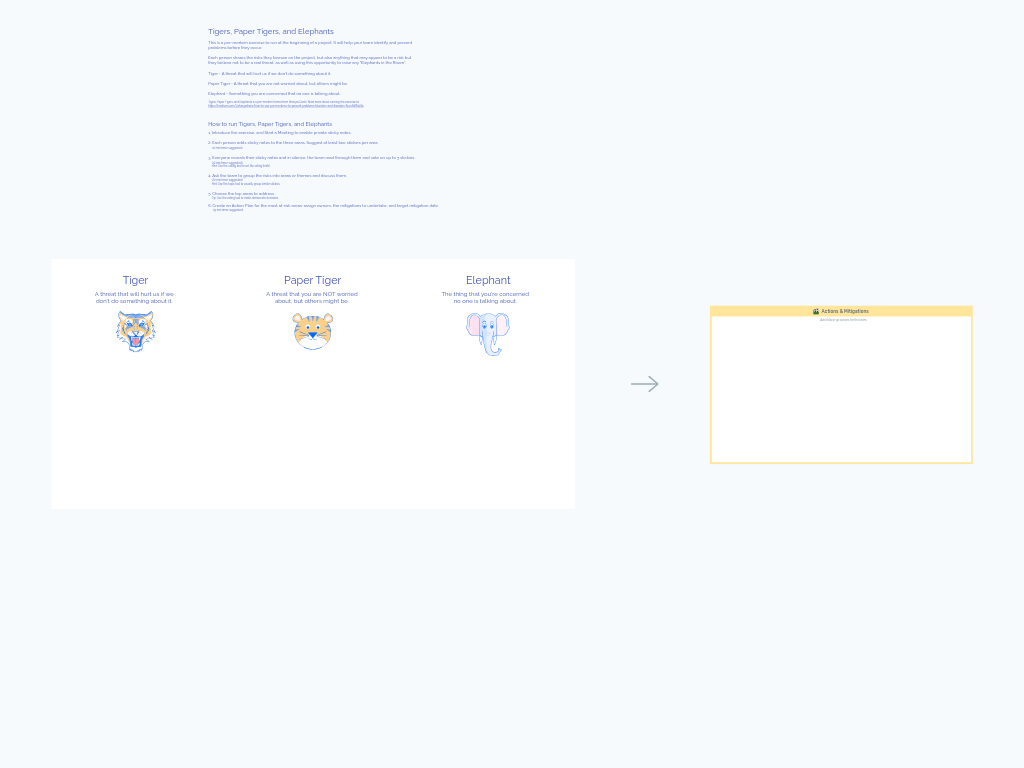Tigers, Paper Tigers, and Elephants
This powerful pre-mortem exercise helps development teams identify and mitigate project risks before they materialize. By distinguishing between real threats (Tigers), perceived threats (Paper Tigers), and unspoken issues (Elephants), teams can create effective risk mitigation strategies for successful project delivery.
What Is the Tigers, Paper Tigers, and Elephants Template?
This pre-mortem format, developed by Shreyas Doshi, is designed to be run at the beginning of a project when there's still time to prevent problems. Unlike traditional retrospectives that look backward, this futurespective approach encourages teams to anticipate challenges proactively.
The template uses three animal metaphors to categorize different types of risks:
- Tigers - Real threats that will harm the project if not addressed
- Paper Tigers - Perceived threats that seem dangerous but aren't genuine concerns
- Elephants - Important issues that everyone knows exist but nobody is discussing openly (the "elephants in the room")
Benefits & When to Use
This template is most valuable when:
- Starting a new project or initiative
- Planning quarterly objectives
- Preparing for a major release
- Onboarding new team members
- After experiencing similar project challenges previously
The exercise helps teams:
- Surface potential roadblocks early enough to address them
- Distinguish between genuine risks and false concerns
- Create psychological safety to discuss uncomfortable topics
- Develop concrete action plans with clear ownership
- Align on priorities and the most critical risk areas
How to Run a Tigers, Paper Tigers, and Elephants Session
Total time: 55-60 minutes
Introduction (5 minutes)
- Explain the concept and the three categories (Tigers, Paper Tigers, Elephants)
- Start a Meeting to enable private sticky notes for honest sharing
- Reference the descriptions in each section to clarify the difference between categories
Individual Reflection (10 minutes)
- Have each team member add at least two sticky notes to each of the three areas
- Encourage specific, actionable descriptions rather than vague concerns
- Remind participants that this is private brainstorming time
Sharing and Discussion (10 minutes)
- Everyone reveals their sticky notes
- The team silently reads through all the inputs
- Use the voting tool to have each team member vote for up to 5 stickies that they believe are most important
- Tip: Click on participants' icons to highlight their specific contributions
Grouping and Analysis (20 minutes)
- Group similar risks into themes or categories
- Discuss patterns that emerge across the three areas
- Pay special attention to risks that appear in multiple categories (one person's Tiger might be another's Paper Tiger)
- Use the Topic tool to visually group similar stickies
Prioritization (5 minutes)
- Select the top risk areas to address based on voting results and discussion
- Use the voting tool to make democratic decisions if needed
Action Planning (15 minutes)
- Create a mitigation plan for each priority risk
- Assign clear owners to each action item
- Set target dates for completing mitigations
- Document actions in the "Actions & Mitigations" zone
Tips for a Successful Session
- Establish psychological safety - Emphasize that identifying risks early is a sign of project strength, not weakness
- Be specific about risks - Vague concerns are difficult to address; encourage detailed descriptions
- Watch for overlap - When the same issue appears as both a Tiger and Paper Tiger, dig deeper to understand perspectives
- Don't rush to solutions - Spend adequate time understanding risks before jumping to action planning
- Follow up regularly - Revisit the risk mitigation plan in subsequent meetings to track progress
- Balance the focus - Don't let Tigers consume all the attention; Elephants often contain the most significant insights
- Consider anonymous sharing - For particularly sensitive topics, allow anonymous submissions to ensure honesty
For more detailed guidance on this technique, you can refer to Shreyas Doshi's article: How to Use Pre-Mortems to Prevent Problems, Blunders, and Disasters



